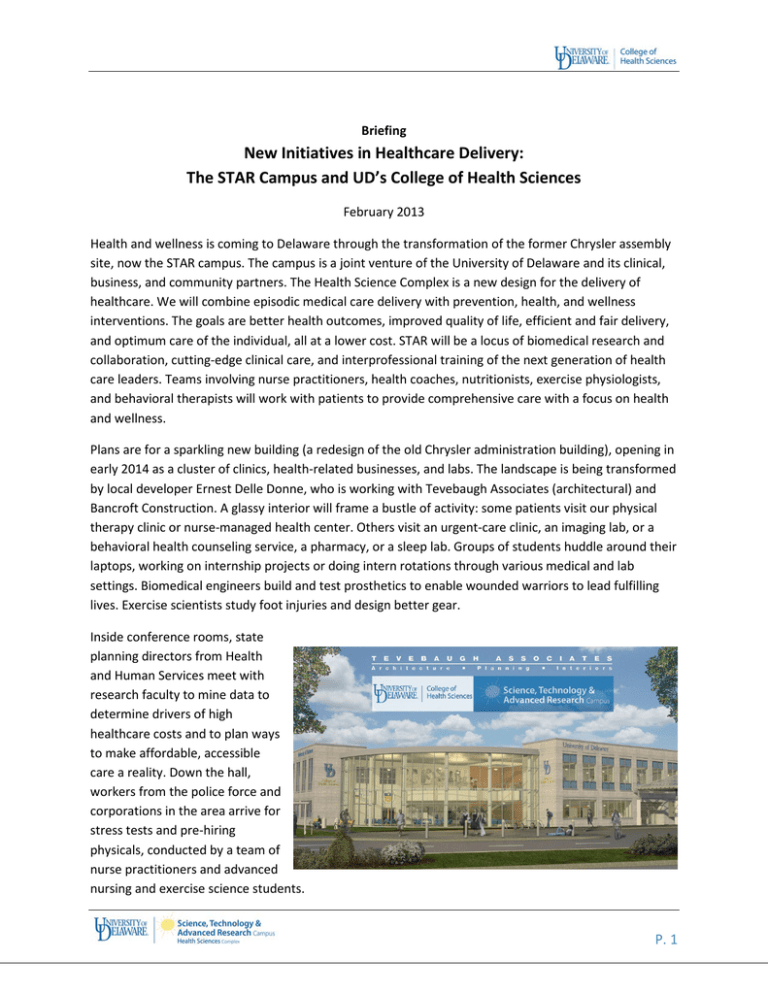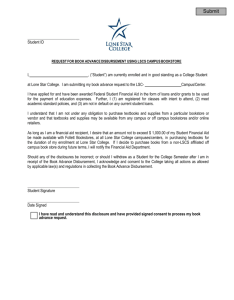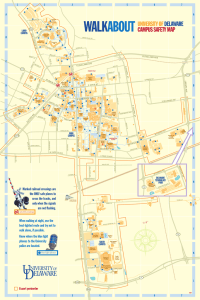New Initiatives in Healthcare Delivery:
advertisement

Briefing New Initiatives in Healthcare Delivery: The STAR Campus and UD’s College of Health Sciences February 2013 Health and wellness is coming to Delaware through the transformation of the former Chrysler assembly site, now the STAR campus. The campus is a joint venture of the University of Delaware and its clinical, business, and community partners. The Health Science Complex is a new design for the delivery of healthcare. We will combine episodic medical care delivery with prevention, health, and wellness interventions. The goals are better health outcomes, improved quality of life, efficient and fair delivery, and optimum care of the individual, all at a lower cost. STAR will be a locus of biomedical research and collaboration, cutting-edge clinical care, and interprofessional training of the next generation of health care leaders. Teams involving nurse practitioners, health coaches, nutritionists, exercise physiologists, and behavioral therapists will work with patients to provide comprehensive care with a focus on health and wellness. Plans are for a sparkling new building (a redesign of the old Chrysler administration building), opening in early 2014 as a cluster of clinics, health-related businesses, and labs. The landscape is being transformed by local developer Ernest Delle Donne, who is working with Tevebaugh Associates (architectural) and Bancroft Construction. A glassy interior will frame a bustle of activity: some patients visit our physical therapy clinic or nurse-managed health center. Others visit an urgent-care clinic, an imaging lab, or a behavioral health counseling service, a pharmacy, or a sleep lab. Groups of students huddle around their laptops, working on internship projects or doing intern rotations through various medical and lab settings. Biomedical engineers build and test prosthetics to enable wounded warriors to lead fulfilling lives. Exercise scientists study foot injuries and design better gear. Inside conference rooms, state planning directors from Health and Human Services meet with research faculty to mine data to determine drivers of high healthcare costs and to plan ways to make affordable, accessible care a reality. Down the hall, workers from the police force and corporations in the area arrive for stress tests and pre-hiring physicals, conducted by a team of nurse practitioners and advanced nursing and exercise science students. P. 1 Amidst the flow of patients in and out of clinical settings, researchers will collect data for their rehabilitation and exercise physiology studies, while economists collect data on healthcare costs. Classes in medical science conducted in electronic classrooms connect medical students and faculty at Thomas Jefferson Medical School in Philadelphia to students at UD. Nursing personnel and physician interns from Christiana and Nemours hospitals join the class from their sites via teleconferencing. The vision does not end with this one building, this beehive of health activity. Behind this first building, a second will go up, a health and wellness facility, where members of the university community and surrounding region work out, using the finest equipment and enjoying the closest attention to physical health and conditioning. Databases keep track of blood pressure, heart rate, body/mass index, and other measures of fitness. Fitness classes, special equipment, and exercise pools serve the needs of those continuing their physical therapies or adapting to advancing age. Exercise science and physical therapy students work one-on-one with a wide range of clients, extending their classroom learning into the activity space. Upstairs at the fitness center, in the demonstration kitchen, an advanced dietetics student teaches practical approaches to nutritional control to community members who have diabetes. The exercise classroom next door is packed with yoga practitioners on their mats. Next to the fitness center, workers are breaking ground on a new building that will house the various departments of UD’s College of Health Sciences—the nursing school, kinesiology and medical lab sciences, behavioral and nutrition sciences. A STAR is born This is the vision for our Health Science Complex, part of a larger and ambitious plan for a new STAR campus at the University of Delaware. This campus is all about partnerships and teamwork: partnering with industry, business, and government to create a new vision of healthcare for our region and to prepare a workforce who can address the challenges we all face in creating a system that is accessible, high quality, evidence-based, and affordable. P. 2 The Health Science Complex is the first-phase buildout of a 272 acre parcel of land located on prime real estate: on the Amtrak line, just off I-95, immediately adjacent to the UD campus. Already, working through the State of Delaware Economic Development Office, Bloom Energy is building a plant on 75 acres, where “Bloom Boxes” will be manufactured using an innovative design that produces electricity from natural gas without relying on combustion. Bloom is representative of the STAR mission: to promote local and regional economic development, deploy the research resources of Delaware’s flagship university, and lead the formation of innovative partnerships with government and industry. Some of the site occupants will be incubated in the nearby Delaware Technology Park, also part of UD, but when they grow large, they will migrate to STAR. The common thread is innovation: in materials science, informatics, cognitive science, sustainable design, energy, and especially, in health sciences. Construction Underway Our Health Science Complex has been jump-started through a real estate development partnership with the premier Delaware developer, Delle Donne Associates. Delle Donne is moving forward rapidly with a total remodel of the administrative building and the high-bay space just behind, with plans for 230,000 square feet of mixed use space: meeting space, classrooms and labs, and health-related businesses. UD will continue to own the land, but Delle Donne will provide up-front capital for construction and lease space to businesses and to UD. Our first tenants on the Health Sciences Complex will be those public-facing clinics at UD that provide a vital interface with the public: our nationally prominent Physical Therapy program ( 2nd in the nation) and our innovative Nurse Managed Health Center. We are tripling the square footage of these clinics from their current space on the main campus. The site is designed for easy parking and access, whether from car or Amtrak. Our opening is planned for January 2014, just one year away. Delle Donne is working closely with prospective business tenants, UD departments, and UD clinics to design spaces for teaching, research, and delivery of clinical care. We share a vision of a green, sustainable campus, one that models and encourages wellness through work, education, and research. We have seen a remarkable response from our business community, so much so that Delle Donne has developed plans for a ten-story business tower on the site, which would make STAR visible from I-95. We have tentative commitments from a wide variety of medical-related businesses: labs, imaging P. 3 centers, behavioral and health counseling, device manufacturers, urgent care clinics, and physicians’ offices. The STAR Campus is a viable catalyst for jobs for the State of Delaware and the surrounding area. STAR will raise the bar for preparing the future healthcare workforce and for retraining the existing workforce. Once developed, the campus will significantly enhance economic development locally, regionally, and even nationally. Expectations are that the STAR campus will be able to go beyond what is typical for the standard research park and create a place where researchers and businesses meet to address pressing needs for healthcare reform. Reaching STAR Goals Interdisciplinary partnerships at STAR will address significant social, civic and scientific challenges. The STAR campus will provide real-world clinical and research settings for training graduate and undergraduate students. Students will profit from easy and frequent movement from class, to clinic, to community, working closely with research and clinical staff to solve real problems in healthcare. Faculty will be poised to collaborate on research initiatives with businesses, government agencies, non-profits, and community health organizations. STAR will contribute to economic development in the region, leading to affordable, evidence-based healthcare delivery in the state. UD is not working alone. We have close working relationships with the State of Delaware and their Department of Health and Social Services, with current projects examining patterns of Medicaid reimbursements, reducing cost of care for frequent visitors to emergency rooms, and training of the Delaware Volunteer Medical Core, a group whose expertise was recently recognized during Hurricane Sandy. We depend increasingly on our partners in the Delaware Health Sciences Alliance (DHSA): Thomas Jefferson University, Nemours/A.I. duPont Hospital for Children, and Christiana Care Health System. We are sponsoring joint research and education initiatives, and the members of DHSA will have a physical presence at STAR. Our new complex will feature teleconferencing classrooms and shared clinical sites for training students. New degree programs are preparing nurse practitioners, behavioral health coaches, and physician’s assistants to assume ever-greater roles in healthcare delivery. Professional education opportunities will upgrade healthcare workforce skills in such areas as evidence-based medicine, health informatics, and behavioral coaching. Healthcare and clinical care delivery will depend increasingly on Interprofessional care teams: nurses, physician’s assistants, nurse practitioners, behavioral and dietetic counselors, psychologists, insurance representatives, legal and fiscal advisors, and continuing wellness and fitness coaches. Our interprofessional education focuses on training both existing and future health care providers in innovative interdisciplinary practices, providing them with a foundation to be committed leaders. We seek to create critical and analytical thinkers--ethical individuals who are active and engaged citizens in their communities. P. 4 This diagram represents the diverse expertise of faculty and programs in the UD College of Health Sciences. New models of healthcare suggest that teams will combine expertise to address all patient needs: medical, behavioral, nutritional, and therapeutic. STAR is our lab for developing interprofessional training and delivering integrated, team-based care. We have multiple areas of expertise and current delivery of clinical services within our College of Health Sciences. The diagram to the right represents an integrated services approach. An initial intake for episodic healthcare or an exam allows us to direct patients to various therapeutic interventions or toward healthy behaviors. The Site Plan The complete redevelopment of this campus “from scratch” provides a unique opportunity to develop a holistic system and plan for innovation and efficiency. The campus will provide modern mixed-use land areas, including retail and housing, a conference center and hotel, as well as a totally reconfigured train station. Funding is already secured for remodeling the station and realigning the rail tracks, with the goal of increasing easy and affordable commuter access by joining SEPTA (Philadelphia) and MARC (DC and Baltimore). Mixed-use buildings located near the train station will have commercial uses located on the first floor with residential or office uses on other floors. The complex will feature indoor and outdoor areas that support an integrated, holistic approach to achieving and maintaining health. Walking and biking paths will extend throughout the campus. Regional multi-use trails will be connected to this campus with additional bike lanes on the streets. New and improved pedestrian and bicycle bridges over the railroad tracks will integrate the STAR campus P. 5 pathway network with the community. The environment will be predominantly urban and walkable, with generous sidewalks and shared travel lanes for bicycles and cars. As well as a health and wellness recreational facility, a continuing-care residential community Is under consideration, as it would offer residents support for access to clinics and labs, fitness facilities, and campus events. A residential community also would offer opportunities to recruit a patient base for gerontological research and longitudinal studies of optimal care for an aging population. Contacts: Kathy Matt, Dean, College of Health Sciences – ksmatt@udel.edu / 302.831.8370 P. 6





